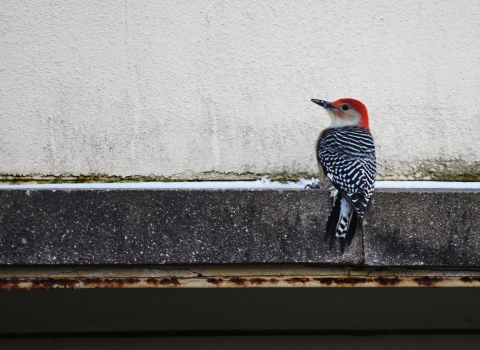We at the U.S. Fish and Wildlife Service know that living close to wooded areas and other natural habitats provides great opportunities to observe wildlife. Sometimes wildlife can get a little too close for comfort. Bats are curious and gentle animals. If a bat has found its way into your home – don’t worry! Below are a few methods for how to safely remove it, including some options where you won’t get too close. Your first thought might be to view bats as pests and call a local pest control company to remove them. Before you pick up the phone, take a moment to learn more about the visiting bat and your options for removing it.
Before you capture, consider the risk of rabies and weather
Never touch a bat with bare hands. If you have been bitten or suspect that you’ve been bitten, call your state health department immediately. Keep the bat contained and follow your state health department’s guidance. They will advise you about where to send the bat for rabies testing, as well as if you need to seek medical assistance.
Weather is an important consideration when deciding how to handle this situation. If you are going to catch and release the bat, make sure weather conditions are above 50°F with no precipitation or high winds. Bats found in buildings during the winter may not survive if released outside in high winds, heavy rain or below‐freezing temperatures. Contact your state wildlife agency or local wildlife rehabilitators for help if you encounter a bat in a building during these types of inclement weather.
Why did it come inside and what if there are more?
Often times, bats fly in through an open door in evenings when the outdoor or garage light is on and attracting insects for the bats to hunt. Keep doors closed and lights off in the evenings to prevent bats from getting trapped in your home.
If you experience recurring bat incidents, search for holes to the exterior. Bats don't make holes; they use what’s there. Bats can squeeze through a crevice as small as a quarter. If you find hibernating bats in the winter, let them stay: a surprise eviction can cause mortalities. Wait until the spring and then install one-way bat tubes to let the bats out and not back in. In the meantime, seal off any openings between roost areas and living spaces to prevent potential rabies exposures.
Many bats are federally protected and mishandling or killing them can result in penalties, unless the bat is posing a threat. Check with your state department of natural resources before excluding a colony of bats.
Passive bat removal methods
- The most basic method is to call for help. Your state department of natural resources may have a biologist willing to remove the bat for you.
- Another method is to let the bat find its own way out. Open as many windows and doors leading to the outside as possible. If it is evening, turn off indoor lights to help the bat navigate its way out.
If it is active and flying, don’t try to catch it and please don’t wave a broom at it. Bats are precision navigators who hunt tiny insects at night so there’s no need to cover your hair because they will avoid flying into you at all costs.
Do-it-yourself bat removal methods
Whether the bat is flying or at rest, begin by closing off the bat to a room or area to keep it contained, away from children and pets, particularly cats who may attempt to attack the bat. If it was highly active, this will encourage it to settle down and stay still enough for you to capture it.
Anytime you approach the bat, move slowly. Fight any urge to quickly scoop, trap or grab the bat. If you move slowly, the bat will likely stay still and not resist or move away from you while you use of these methods to capture and release it.
Remember to always be gentle with the bat, their wings and feet are very delicate. The bat is likely just trying to find a place to sleep, but staying in your home isn’t a safe place for them or you.
- Option 1: Trap the bat in a sturdy container, such as a shoe box — something large enough to keep their delicate wings and feet from getting crushed under the rim. Use the familiar bug-trapping-method by slowly placing the container over the bat and slipping cardboard under the opening to safely enclose the animal.
- Option 2: Gently and slowly pick up the bat while protecting your hands. Bats can easily bite through single and double layers of cotton. To avoid a potential rabies exposure, use thick work gloves lined with leather or another strong material. Quickly and gently pick the bat off the wall or up from the ground. Fully encompass their wings and body when grabbing the bat so it is unable to harm itself by flapping around.
- Option 3: If you don’t have good gloves or aren’t comfortable picking the bat up, try gently scooping it into a bag or other tightly knit material. Avoid loosely knit materials, such as bath towels, which have loops in the threads that bat claws can get caught in.
Once you’ve captured your bat, head outside to release it by holding it high-up and away from your body. If weather conditions are suitable but the bat won’t take-off, find an elevated surface to let it rest on until it’s ready to fly. Don’t leave your bat on the ground, they need to catch some air in order to take flight.
Bats can be good neighbors
Many homeowners appreciate bats for their insect control services, which save their gardens from pests and save themselves from itchy mosquito bites. Consider putting up a bat house before you evict a colony from your home, and they may move in or occupy it upon return in the spring.
Lots of people enjoy having bats around. You might not want them sleeping in your room, but they are a part of a healthy backyard ecosystem. If you get a chance to see one up-close, notice what amazing creatures they are!







